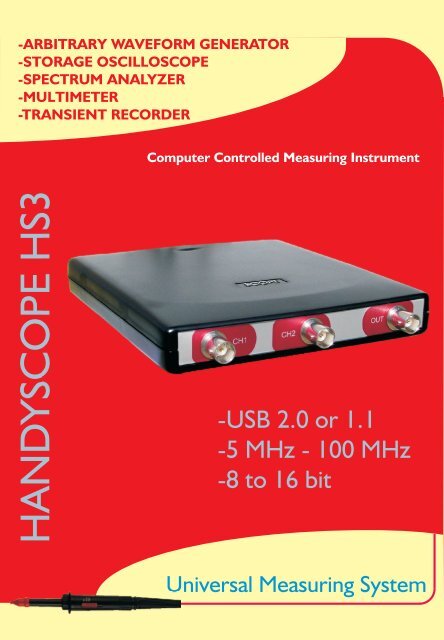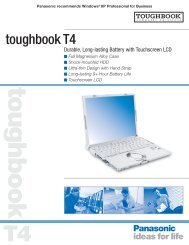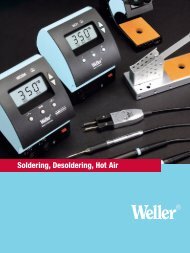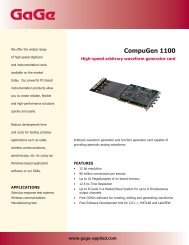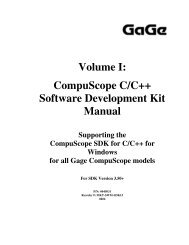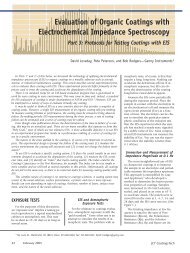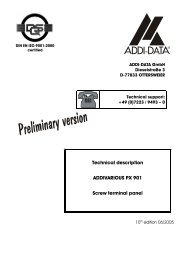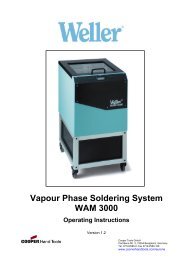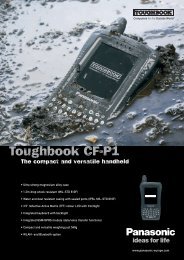Handyscope HS3 - TiePie engineering
Handyscope HS3 - TiePie engineering
Handyscope HS3 - TiePie engineering
- No tags were found...
You also want an ePaper? Increase the reach of your titles
YUMPU automatically turns print PDFs into web optimized ePapers that Google loves.
-ARBITRARY WAVEFORM GENERATOR-STORAGE OSCILLOSCOPE-SPECTRUM ANALYZER-MULTIMETER-TRANSIENT RECORDERComputer Controlled Measuring InstrumentHANDYSCOPE <strong>HS3</strong>-USB 2.0 or 1.1-5 MHz - 100 MHz-8 to 16 bitUniversal Measuring System
HANDYSCOPEThe <strong>Handyscope</strong>-<strong>HS3</strong> is a powerful computer controlledmeasuring instrument that consists of four measuringinstruments: a Multimeter, Oscilloscope, Spectrum analyzerand Transient recorder. Also an AWG (Arbitrary WaveformGenerator) is available. This new powerful and compactmeasuring instrument can solve almost every measurementproblem.With the integrated AWG you can generate any signal youwant. The software is easy-to-use and has a lot of analyzingtools that will improve productivity and measuring quality. Alarge full screen signal display, storage and analyzingcomplex signals, advanced trigger facilities and great colorprint out is the new way for measuring and analyzing yoursignals today.The arbitrary waveformgenerator offers five defaultsignal shapes: sine wave,triangle, square, DC and whitenoise with a 14 bit resolution.The selected signal shape isimmediately shown in thedisplay of the generator.The amplitude of the signal canbe freely set between 0 V and±12 V peak. A DC offset between 0 and ±12 V can be applied to the signal.Also the symmetry of the signal can be changed, from 1% to 99%. Thefrequency of the signal can be set from almost 0 to 2 MHz.
The oscilloscope is an instrumentwith which electrical voltagesvarying in time can be displayed.With the oscilloscope timedependent electrical signals canbe examined easily.The 100 MHz* samplingoscilloscope has separatedvoltage input channels, which canbe configured individually. It is adigital sampling oscilloscope. Thatmeans that the oscilloscope takessamples at fixed times. From each sample the value is determined and the size isdisplayed at the screen. The screen is filled with all samples. Between two adjacentsamples on the screen a line is drawn. The speed at which the samples are taken, isadjustable.Cursors are available to perform voltage, time or frequency measurements on thedisplayed signal.* Sample rate depends on the model. Sample rate ranges are: 5 MHz, 10 MHz, 25 MHz, 50 MHz, 100MHz.When a quick indication of the input signal isrequired, a simple click on the auto setupbutton will immediately give a good overviewof the signal. The auto setup function ensures aproper setup of the time base, the trigger levels and theinput sensitivities.Two sophisticated cursor read outs have 21possible read outs. Besides the usual read outs,like voltage and time, also quantities like risetime and frequency are displayed.T&M Instruments Instruments For The PC For The PC
The common way to examineelectrical signals is in the timedomain, using an oscilloscope.The time domain is used todetermine amplitude, time andphase information, which isnecessary to describe thebehaviour of an electrical system.Not all electrical systems can becharacterised in the time domain.Circuits like filters, amplifiers,oscillators, mixers, modulators anddetectors can be characterised best by their frequency behaviour. That frequencybehaviour is best obtained by observing the electrical signals in the frequency domain. Todisplay the frequency domain, an instrument is needed that can distinguish differentfrequencies from each other and measure the signal size at the different frequencies. Aninstrument that can display the frequency domain is the spectrum analyzer. It graphicallydisplays voltage as a function of frequency.If from the input signals only the size is importantand not the time information or frequencycomponents, a voltmeter is a suitable instrumentto measure with. The software is equipped with atwo channel digital voltmeter. The voltmeterfunctions as follows:1: A measurement is performed (minimal 200samples). 2: The measured data is processed, e.g.for calculating the RMS value or the mean value.Eleven different operations are available. 3: The calculated values are displayed, e.g. addCH1 and CH2 and display on channel one. Sixteen different display methods are available.For each channel the voltmeter has up to three displays to present the measured andcalculated values. The value displayed in a display is fully configurable. Also for each displaya bar graph is available, to give a quick overview of the signal size in relation to the inputrange.
For measuring slowly changingsignals (e.g. the temperaturechange in a room) the transientrecorder is the most suitableinstrument.The transient recorder is a twochannel, direct registeringmeasuring instrument, displayingthe changes of the input signalgraphically on the screen or onpaper.The transient recorder measures at settable, fixed times and processes the measured valueif necessary. The number of measurements to be taken is also settable.The transient recorder measures the input signals at adjustable times. The time betweentwo measurements is adjustable from 0.01 second to 500 seconds. The number ofsamples is also adjustable from 1 to 131060. The maximum measuring time is 500 sec x131060 samples = 65530000 seconds (758 days).The probe HP9060 is a 1:1-1:10 selectable passivehighimpendance oscilloscope probe designed andcalibrated for use on the <strong>Handyscope</strong>. The probeincorporates a three position slide switch in the headwhich selects the attenuation of X1, X10 or a groundreference position. The X10 attenuation is achievedby means of an attenuation network. The <strong>Handyscope</strong>is standard deliverd with two HP9060 probes.T&M Instruments For The PC For The PC
<strong>Handyscope</strong>-<strong>HS3</strong> SoftwareCursor read outResolution:14 bitRead outs: True RMS, Peak-Peak, Mean, Output impedance:50 OhmOscilloscopeMaximum, Minimum, dBm, Power, Frequency range:0-2 MHzBandwidth:25 MHz Crest factor, Frequency, Duty cycle,Frequency step:0.01HzSample rate maximum: See ordering Rise time left and right, slew rate leftOutput amplitude: 0 - ±12 voltSample rate minimum: 0.01 Hzand right, THD (in spectrum analyzer)Fonts:user selectable Amplitude step: 0 - ±0.1 Volt 8192 stepsTime base:to 655 ksec/divColours: background user selectable±0.1 - ±1.0 Volt 8192 stepsTime base magnification: 1 x to 50 x±1.0 - ±12 Volt 8192 stepsY-axis setting: drop and drag Comment DC level: 0 - ±12 Volt in 8192 stepsPre samples:0 to 131060 User text: three text lines for everyWaveforms: sine, triangle, square, noise,Post samples:0 to 131060print outDC and user defined (256 Kword)Trigger time out: 0 to infinite sec.Comment text: three special text linesText balloons: user selectable text, Symmetry:1-99%, 1% stepsTrigger input: CH1, CH2, EXT, keyboardcolours and arrowsMeasuring modes:GeneralCH1, CH2, CH1+CH2, CH1-CH2, Print outPower supply:from USB portCH2-CH1 and X-Y mode. Size:full printer size (A4, A3)Power consumption: 500 mAmp @ 5VoltReferency:CH1, CH2 Colours: black / white and colour printsConnection: USB 1.1 and USB 2.0 portCable length: 1.8 meter (70 inch)Spectrum analyzer<strong>Handyscope</strong>-<strong>HS3</strong> HardwareAmbient temperature: 15 °C to 25 °CMax frequency rate: Sample rate/2(59 °F to 77 °F)Min frequency rate: 0.003 Hz Aquisition system Dimensions: 25x170x140mm (H x L x W)Frequency accuracy:


